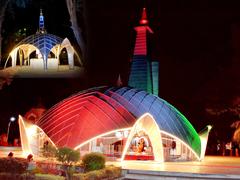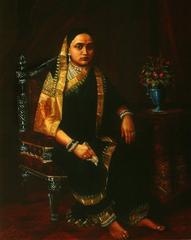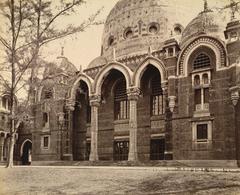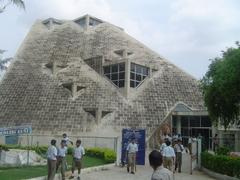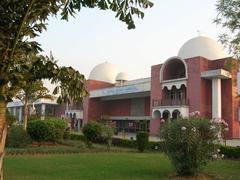
Comprehensive Guide to Visiting Vadodara, Vadodara District, India
Published Date: 14/08/2024
Captivating Introduction
Welcome to Vadodara, a city where history, culture, and modernity dance together like an intricately choreographed Garba performance. Nestled in the heart of Gujarat, Vadodara, also known as Baroda, is a treasure trove of architectural marvels, vibrant traditions, and rich heritage. Imagine strolling through a city where every stone has a story, from the bustling trade center of Ankottaka in the 9th century to the cultural renaissance under the Gaekwad dynasty in the 18th century. Picture yourself standing before the majestic Laxmi Vilas Palace, a structure so grand that it dwarfs Buckingham Palace, or losing yourself in the vibrant hues of the Navratri festival, where the city comes alive with nine nights of non-stop dancing and celebration (Wikipedia, Face of Gujarat, Skysafar).
Vadodara’s history is a rich tapestry woven with threads of Jainism, Solanki Rajputs, Delhi Sultanate, Mughal Empire, and the visionary Gaekwad dynasty. Maharaja Sayajirao Gaekwad III, the city’s most famous ruler, transformed Vadodara into a beacon of education, culture, and social reform. Under his reign, the city earned the titles ‘Kala Nagari’ (City of Art) and ‘Sanskrutik Nagari’ (Cultural City). Today, Vadodara is not just a city; it’s a living museum where the past and present coexist in perfect harmony, offering an unforgettable journey through time and culture (Wikipedia, Face of Gujarat).
Table of Contents
- [History of Vadodara](#history-of-vadodarahistory-of-vadodara)
- [Early History and Etymology](#early-history-and-etymologyearly-history-and-etymology)
- [Ancient and Medieval Periods](#ancient-and-medieval-periodsancient-and-medieval-periods)
- [The Gaekwad Dynasty](#the-gaekwad-dynastythe-gaekwad-dynasty)
- [Architectural Marvels](#architectural-marvelsarchitectural-marvels)
- [Colonial Era and Independence](#colonial-era-and-independencecolonial-era-and-independence)
- [Post-Independence Era](#post-independence-erapost-independence-era)
- [Cultural Significance](#cultural-significancecultural-significance)
- [Historical Landmarks](#historical-landmarkshistorical-landmarks)
- [Why Vadodara is Your Next Must-Visit Destination](#why-vadodara-is-your-next-must-visit-destinationwhy-vadodara-is-your-next-must-visit-destination)
- [Step Back in Time](#step-back-in-timestep-back-in-time)
- [Architectural Wonderland](#architectural-wonderlandarchitectural-wonderland)
- [The Cultural Vibe](#the-cultural-vibethe-cultural-vibe)
- [Economic Pulse](#economic-pulseeconomic-pulse)
- [Educational Powerhouse](#educational-powerhouseeducational-powerhouse)
- [Nature’s Retreat](#natures-retreatnatures-retreat)
- [Hidden Treasures](#hidden-treasureshidden-treasures)
- [Foodie’s Paradise](#foodies-paradisefoodies-paradise)
- [Insider Tips](#insider-tipsinsider-tips)
- [Major Attractions in Vadodara](#major-attractions-in-vadodaramajor-attractions-in-vadodara)
- [Introduction](#introductionintroduction)
- [Laxmi Vilas Palace](#laxmi-vilas-palacelaxmi-vilas-palace)
- [Sayaji Baug (Kamati Baug)](#sayaji-baug-kamati-baugsayaji-baug-kamati-baug)
- [Baroda Museum & Picture Gallery](#baroda-museum—picture-gallerybaroda-museum—picture-gallery)
- [Maharaja Fateh Singh Museum](#maharaja-fateh-singh-museummaharaja-fateh-singh-museum)
- [EME Temple](#eme-templeeme-temple)
- [Kirti Mandir](#kirti-mandirkirti-mandir)
- [Sayaji Sarovar](#sayaji-sarovarsayaji-sarovar)
- [Sursagar Lake](#sursagar-lakesursagar-lake)
- [Hazira Maqbara](#hazira-maqbarahazira-maqbara)
- [Mandvi Gate](#mandvi-gatemandvi-gate)
- [ISKCON Temple Vadodara](#iskcon-temple-vadodaraiskcon-temple-vadodara)
- [Ajwa Nimeta Garden](#ajwa-nimeta-gardenajwa-nimeta-garden)
- [Nyay Mandir](#nyay-mandirnyay-mandir)
- [Tapovan Temple Vadodara](#tapovan-temple-vadodaratapovan-temple-vadodara)
- [Sardar Patel Planetarium](#sardar-patel-planetariumsardar-patel-planetarium)
- [Sardar Patel Zoological Park](#sardar-patel-zoological-parksardar-patel-zoological-park)
History of Vadodara
Early History and Etymology
Welcome to Vadodara, the city where history and culture intertwine like the roots of its namesake banyan tree. Vadodara, formerly known as Baroda, derives its name from ‘Vatodar,’ meaning ‘in the heart of the banyan tree.’ This ancient city has stories buried deep within its soil, just waiting for you to unearth them (Wikipedia).
Ancient and Medieval Periods
Picture this: it’s the 9th century, and Vadodara, then called Ankottaka, is buzzing as a significant Jain hub. The Solanki dynasty turns the city into a bustling center of trade and culture from the 10th to the 13th centuries. By the 14th century, the Delhi Sultanate takes over, followed by the Gujarat Sultanate, and then the Mughals in the 16th century, each leaving their unique imprint on the city.
The Gaekwad Dynasty
Fast forward to the 18th century, and Vadodara becomes the gem in the crown of the Maratha Empire. The Gaekwad dynasty, founded by Pilaji Rao Gaekwad in 1721, transforms the city into a prosperous and culturally vibrant metropolis. Maharaja Sayajirao Gaekwad III, ruling from 1875 to 1939, is the visionary leader who earns Vadodara the titles ‘Kala Nagari’ (City of Art) and ‘Sanskrutik Nagari’ (Cultural City) for his reforms in education, infrastructure, and social welfare (Wikipedia).
Architectural Marvels
Now, let’s take a stroll through Vadodara’s architectural wonders. Imagine yourself standing before the grand Laxmi Vilas Palace, four times the size of Buckingham Palace! Built by Maharaja Sayajirao Gaekwad III, this Indo-Saracenic marvel is still home to the royal family and is open to the public. You’ll be awestruck by its splendid collection of artifacts and artwork (Face of Gujarat).
Nearby, the Champaner-Pavagadh Archaeological Park, a UNESCO World Heritage Site, offers a fascinating blend of Hindu and Islamic architecture, making for a captivating day trip (Skysafar).
Colonial Era and Independence
Under British colonial rule, Vadodara thrives under the semi-autonomous Gaekwad rulers. The city becomes an educational hub with institutions like the Maharaja Sayajirao University of Baroda, established in 1949, fostering intellectual and cultural growth. The Gaekwads’ progressive policies, including the abolition of untouchability and promotion of women’s education, pave the way for Vadodara’s modern identity.
Post-Independence Era
Post-independence, Vadodara integrates into the state of Gujarat and continues its growth, becoming a major industrial and commercial center. Today, Vadodara is celebrated for its vibrant cultural heritage, esteemed educational institutions, and booming industries.
Cultural Significance
Vadodara is a cultural kaleidoscope. The annual VadFest, also known as the Vadodara International Art and Culture Festival, attracts artists, musicians, and performers from around the globe. This festival is a riot of colors and creativity, celebrating classical music, dance, theater, and visual arts (Face of Gujarat).
Navratri in Vadodara is another spectacle you shouldn’t miss. Imagine nine nights of traditional Garba and Dandiya-Raas dances, with people from all walks of life coming together in vibrant and colorful celebrations (Audiala).
Historical Landmarks
Sayaji Baug
Escape to the lush green haven of Sayaji Baug, also known as Kamati Baug. Spread over 100 acres, this garden, named after Maharaja Sayajirao Gaekwad III, is a serene retreat with lovely flowerbeds, lawns, and tranquil water features (Face of Gujarat).
Baroda Museum and Picture Gallery
Dive into Vadodara’s past at the Baroda Museum and Picture Gallery. Built in 1894 by the Gaekwads, this museum showcases a diverse collection of artwork, relics, and historical displays, offering a window into the city’s rich heritage (Skysafar).
Nyaya Mandir
Step into the architectural splendor of Nyaya Mandir, or the Temple of Justice. Built in 1896 and designed by Robert Fellowes Chisholm, this building combines Gothic, Renaissance, and Mughal styles, making it a must-see attraction in Vadodara (Skysafar).
Why Vadodara is Your Next Must-Visit Destination
Step Back in Time
Ever wondered what it feels like to walk through centuries of history in just a day? Welcome to Vadodara, or Baroda as the locals fondly call it, a city where every stone has a story. Starting from the 10th century, this place has seen the mighty Solanki Rajputs, the Delhi Sultanate, and the Mughal Empire. But it was under the Gaekwad dynasty in the 18th century that Vadodara truly flourished. Picture this: Maharaja Sayajirao Gaekwad III, the wizard behind Vadodara’s transformation, giving the city its first taste of electricity, industrial growth, and compulsory education for all kids. Now, isn’t that cool? (India Imagine).
Architectural Wonderland
Hold your breath as you step into Lakshmi Vilas Palace, a structure so grand it makes Buckingham Palace look like a dollhouse. Built in 1890 by Maharaja Sayajirao Gaekwad III, this palace is a masterpiece of Indo-Saracenic architecture. Wander through the Darbar Hall, marvel at the Moti Baug Palace, or get lost in the art collections at the Maharaja Fateh Singh Museum. And hey, don’t forget to snap a selfie! (FabHotels).
If that’s not enough, check out the Italian-inspired Makarpura Palace, the exhibition-filled Nazarbaug Palace, and the serene Kirti Mandir. Oh, and Tambekar Wada will make you wish your house had four stories too! (Wanderlog).
The Cultural Vibe
Think of Vadodara as the cultural heart of Gujarat. With the Maharaja Sayajirao University (MSU) at its core, this city attracts students like bees to honey. Especially the Faculty of Fine Arts—it’s the Hogwarts for budding artists! (Outlook India).
And if you love festivals, you’re in for a treat. Navratri here is like nothing you’ve ever seen—nine nights of non-stop garba dancing. And don’t miss the Vadodara International Festival and the Garba Festival. It’s like a cultural buffet! (Get Roamer).
Economic Pulse
Vadodara isn’t just about culture; it’s an economic dynamo too. With industries ranging from petrochemicals to pharmaceuticals, the city is a major contributor to Gujarat’s GDP. Think of it as the Silicon Valley of Western India (India Imagine).
Educational Powerhouse
MSU isn’t just a university; it’s a legacy left by Maharaja Sayajirao Gaekwad III. Offering a plethora of programs, it’s the go-to place for education in Gujarat. And the Faculty of Fine Arts? It’s the breeding ground for India’s next Picasso (Outlook India).
Nature’s Retreat
Take a breather at Sayaji Garden, a sprawling 100-acre oasis in the city. Whether it’s the Sardar Patel Planetarium, the Baroda Museum & Picture Gallery, or the toy train, there’s something for everyone. And don’t miss the floral clock—it’s Instagram gold! (FabHotels).
For a more serene vibe, head to Sur Sagar Lake. With a 120-feet statue of Lord Shiva at its center, it’s the perfect spot for an evening stroll (FabHotels).
Hidden Treasures
Vadodara is your gateway to some of Gujarat’s best-kept secrets. The Champaner-Pavagadh Archaeological Park, a UNESCO World Heritage Site, is just a drive away. Blend Hindu and Islamic architecture? Yes, please! And don’t miss the historic towns of Dabhoi and Pavagadh (Get Roamer).
Foodie’s Paradise
If you’re a food lover, Vadodara will spoil you. Dive into traditional Gujarati fare like Gujarati thali, khaman, and handvo. Pro tip: A food trail through the city’s bustling markets is a must (Get Roamer).
Insider Tips
- Best Time to Visit: November to February. Trust us, the weather’s perfect.
- How to Get There: Fly into Vadodara’s domestic airport or take a train—it’s a major hub on the Western Railway. Road trips? Totally doable.
- Where to Stay: From budget homestays like G Homestay to luxurious spots like Vivanta Vadodara, there’s something for everyone (Explore with Ecokats).
So what are you waiting for? Download the Audiala app and unlock the secrets of Vadodara. Your adventure awaits!
Major Attractions in Vadodara
Introduction
Welcome to Vadodara, a city where history meets modernity, and where every corner has a story to tell. Known as the cultural capital of Gujarat, Vadodara offers a treasure trove of experiences that cater to all kinds of travelers. Whether you’re a history buff, a nature enthusiast, or a spiritual seeker, Vadodara promises an enriching and memorable visit.
Laxmi Vilas Palace
Imagine a palace four times the size of Buckingham Palace! That’s Laxmi Vilas Palace for you—built in 1890 by Maharaja Sayajirao Gaekwad III, this architectural marvel blends Hindu, Gothic, and Mughal styles. Wander through the opulent Darbar Hall, with its Venetian mosaic flooring and Belgian stained glass windows, and don’t miss the royal family’s museum and the 9-hole golf course on the palace grounds (Wikipedia).
Sayaji Baug (Kamati Baug)
Sayaji Baug is not just a garden; it’s a 45-hectare wonderland established in 1879. Picture this: 98 types of trees, two museums, a zoo, a planetarium, a flower clock, and a toy train. The Baroda Museum and Picture Gallery within the garden is a must-visit, showcasing a rich collection of art and natural history (Travel Triangle).
Baroda Museum & Picture Gallery
This museum, founded in 1894, is modeled after London’s Victoria and Albert Museum. Its eclectic collection ranges from an Egyptian mummy to 5th-century Akota bronzes and a blue whale skeleton. Art lovers will appreciate the European paintings by Turner and Constable (Travel Setu).
Maharaja Fateh Singh Museum
Initially a school for royal children, this museum now houses a vast collection of European and Indian art, including works by Raja Ravi Varma. It’s a must-visit for art aficionados (Travel Setu).
EME Temple
Managed by the Indian Army, the EME Temple is an architectural wonder with its aluminum-clad structure. Dedicated to Lord Shiva, the temple is surrounded by a garden featuring 106 ancient statues (Travel Triangle).
Kirti Mandir
Built in 1936, Kirti Mandir commemorates Maharaja Sayajirao Gaekwad III’s ancestors. The temple features murals by Nandalal Bose and offers a glimpse into the Gaekwad dynasty’s contributions (Travel Setu).
Sayaji Sarovar
Also known as Ajwa Reservoir, this spot is perfect for picnics and nature walks. The nearby Ajwa Nimeta Garden, with its musical fountains, is a family favorite (Travel Setu).
Sursagar Lake
An artificial lake with a 120-foot statue of Lord Shiva in its center, Sursagar Lake is a popular evening spot for boating and leisurely walks (Travel Setu).
Hazira Maqbara
This 16th-century mausoleum is the final resting place of Mughal noble Qutb-ud-din Muhammad Khan and his son. Its Mughal architecture and serene gardens make it a hidden gem for history enthusiasts (Travel Setu).
Mandvi Gate
A historical landmark from the Mughal era, Mandvi Gate was once a toll gate for traders. Today, it’s a bustling market area perfect for experiencing local culture and shopping for souvenirs (Travel Triangle).
ISKCON Temple Vadodara
Part of the International Society for Krishna Consciousness, this temple is known for its grand architecture and serene ambiance. Participate in daily rituals and enjoy vegetarian food at the temple’s restaurant, Govindas (Travel Triangle).
Ajwa Nimeta Garden
This amusement park near the Ajwa Reservoir features musical fountains, lush lawns, and rides for children. It’s a great spot for family picnics and weekend getaways (Travel Setu).
Nyay Mandir
Built in 1896, this historic courthouse is an architectural marvel. It houses the District Court of Vadodara and offers a glimpse into the city’s judicial history (Travel Setu).
Tapovan Temple Vadodara
Dedicated to various Hindu deities, this temple complex is a peaceful retreat surrounded by greenery. It hosts various religious events throughout the year (Travel Setu).
Sardar Patel Planetarium
Located within Sayaji Baug, this planetarium offers educational shows and exhibitions about the universe, making it a great spot for families and students (Travel Triangle).
Sardar Patel Zoological Park
Inaugurated by Prime Minister Narendra Modi, this park is home to around 170 species of wildlife, including exotic birds and Royal Bengal Tigers. It’s quickly become a popular tourist attraction (Travel Triangle).
Vadodara, with its rich cultural heritage and diverse attractions, offers a memorable experience for every visitor. From historical monuments and museums to serene lakes and vibrant gardens, the city has something for everyone. Whether you are a history buff, nature lover, or spiritual seeker, Vadodara promises an enriching and enjoyable visit.
Call to Action
Vadodara is a city that invites you to step back in time while embracing the vibrancy of the present. From the grandeur of Laxmi Vilas Palace to the tranquil beauty of Sayaji Baug, Vadodara is a city where every corner has a story to tell. Its rich history, diverse cultural heritage, and modern-day dynamism make it a must-visit destination for any traveler. Whether you’re exploring the architectural wonders, participating in the exuberant Navratri celebrations, or savoring the local cuisine, Vadodara offers a unique and enriching experience that will leave you with memories to cherish (Wikipedia, India Imagine, FabHotels, Wanderlog).
Ready to uncover more? Download Audiala, your ultimate tour guide app, for expertly crafted audio guides that reveal Vadodara’s hidden gems and stories. Embark on this unforgettable journey and let Vadodara’s charm captivate you!
References
- Wikipedia, 2021, Vadodara
- Face of Gujarat, 2023, Best places to visit in Vadodara
- Skysafar, 2023, Top 28 best places to visit in Vadodara
- India Imagine, 2023, Vadodara: The Cultural Capital of Gujarat
- FabHotels, 2023, Places to visit in Vadodara
- Wanderlog, 2023, Most historic buildings and sites in Vadodara
- Outlook India, 2023, Vadodara: Cultural Capital of Gujarat
- Get Roamer, 2024, Vadodara travel guide
- Explore with Ecokats, 2023, Things to do in Vadodara
- Travel Triangle, 2023, Best places to visit in Vadodara
- Travel Setu, 2023, Vadodara tourism guide


